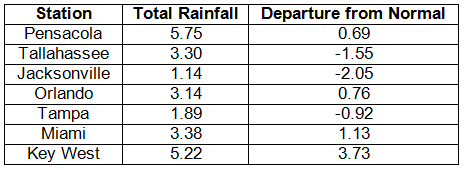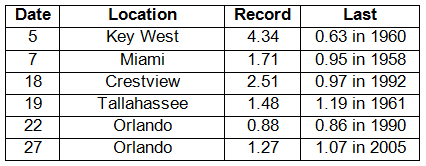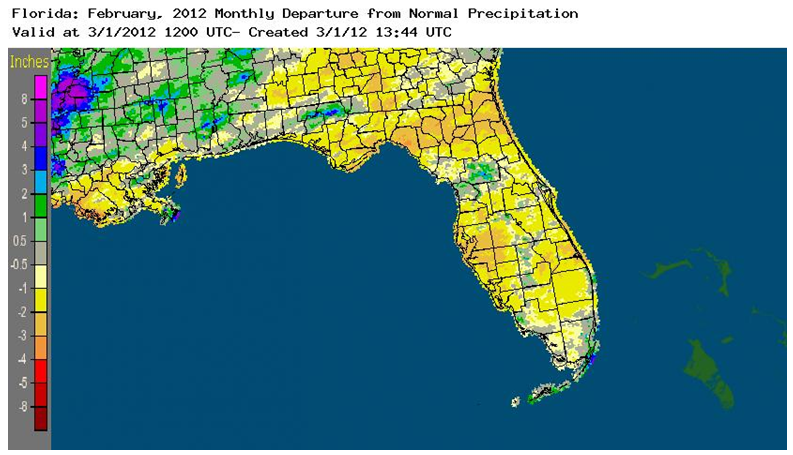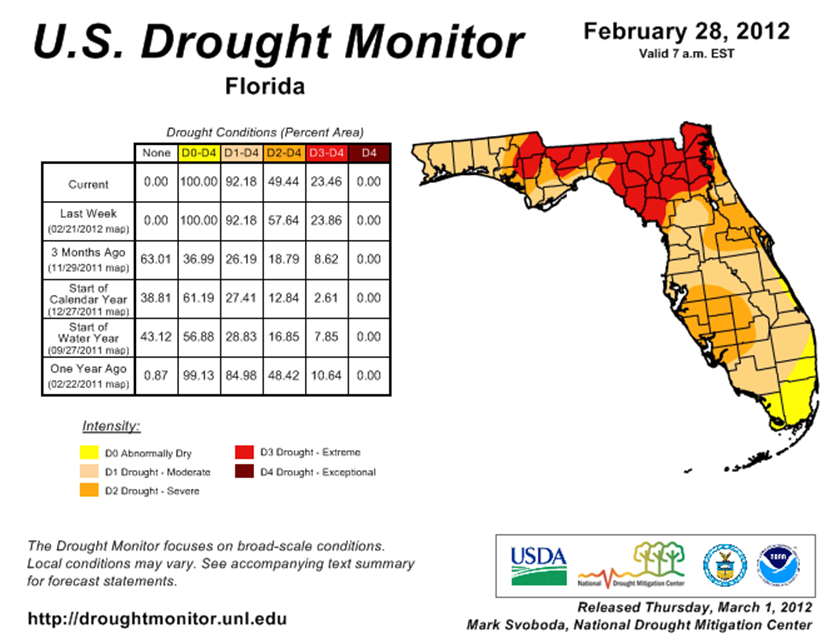| Quick Facts | |
1,159 Registered FL Observers
463 Active FL Observers
10,988 FL Reports Submitted during 2/12
Greatest # of Daily Reports Submitted during February: 409 on 2/7/12
Most Rainfall Reported during February: 4.8" on 2/7/12 from Station FL-MD-6 |
|
|
|
March Madness |
If you made your daily report this morning, then you saw the notice about our annual March Madness contest. For those of you new to the network, we are running a little friendly competition at CoCoRaHS called 'March Madness' (not to be confused with the NCAA Basketball Tournament). We are trying to see which state can recruit the most observers in the month of March. So if you know someone (relative or friend) who might be interested in joining the program, now would be a perfect time to get him or her to sign up. |
|
Spring Ahead! |
Just a friendly reminder to everyone that Daylight Saving Time begins at 2:00 AM on March 11. Make sure before you go to bed the night of the 10th that you turn your clock ahead by one hour to reflect the change. Just to let you know, your CoCoRaHS observations will continue to stay on local time. If your normal observation time was at 7 AM EST, it becomes 7 AM EDT after the time change. This should help avoid some confusion, but if you have questions, please feel free to drop me an email. |
|
Flood Safety Week |
Starting March 12, NOAA and the National Weather Service are hosting a Flood Awareness Week. This week of activities will highlight some of the many ways floods can occur, the hazards associated with floods, and what you can do to save life and property in the event of a flood.
For more information, visit:
http://www.floodsafety.noaa.gov/. |
|
February Rains |
Rainfall totals varied statewide in February (Table 2). Most stations saw below normal rainfall, while some stations saw slightly above normal rainfall for the month. Portions of Holmes, Jackson, and Washington counties in the Panhandle saw rainfall totals approximately 3.00" above normal. Heavy rains impacted The Keys and coastal Dade County at the beginning of the month, and the middle of the month brought heavy rains to portions of the Panhandle (Table 3). Areal patterns of monthly rainfall relative to normal are depicted in Figure 1.
| Table 1: February precipitation totals and departures from normal (inches) for select cities. |
|  |
|
Table 2: Daily rainfall records (inches) broken during February (compiled from NOAA, NWS). |  |
|
|
Figure 1: A graphical depiction of the monthly rainfall departure from normal (inches) for February (courtesy of NOAA, NWS) |  |
|
|
February CoCoRaHS Totals |
Here are the CoCoRaHS rainfall totals for February from some select CoCoRaHS stations across the state.
| |
|
Current State of the Drought |
Since the beginning of February, the drought conditions have gotten worse in some areas. The area of extreme drought expanded from just a few counties in the Panhandl, to include most of North Florida and the Big Bend region. At one point during February, the National Drought Monitor had Gadsden, Leon, Jackson, Jefferson, Washington, and Calhoun counties under D4 drought designation, signifying an exceptional drought. Rains during the 18th and 19th eased those areas back into an extreme drought classification. The rest of the state has seen below normal precipitation as well, leading to the expansion of severe drought along the Sun and Space Coasts. Even though La Niņa is forecasted to transition to neutral conditions during the next three months, current predictions still have most of the southeastern U.S. experiencing warmer than normal temperatures and below normal precipitation.
The National Drought Monitor is updated weekly, so you can always check the most recent conditions here: http://www.drought.unl.edu/dm/DM_state.htm?FL,SE.

|
|
|
Odds and Ends |
Your individual quality control efforts continued to prove helpful, as we had no flagged values for the month of February. If you receive an email from me with the subject line 'Question About Your Recent CoCoRaHS Observation', please take a moment to answer me back. And if you have any questions, please feel free to contact me.
You can now 'Like' Florida CoCoRaHS on Facebook! By joining our Facebook page, the latest Florida CoCoRaHS news items will automatically show up in your "news feed" when you first login to Facebook. To join, click the "Find us on Facebook" link in the menu bar of this email, then click the "like" button on our Facebook page. | |
|
Thank You!
Thank you for your continued support and enthusiasm! If at any time you have questions about CoCoRaHS, reading your rain gauge, or finding a location to setup your rain gauge, please feel to contact a Florida CoCoRaHS Coordinator. We are lucky enough to have regional support from National Weather Service offices across the state, as well as county/local help from several CoCoRaHS volunteers.
 Melissa Griffin Florida CoCoRaHS State Coordinator Assistant State Climatologist Florida Climate Center/Center for Ocean-Atmospheric Prediction Studies Florida State University 232 R.M. Johnson Building Tallahassee, FL 32306-2840 (850) 644-0719 griffin@coaps.fsu.edu | |
|